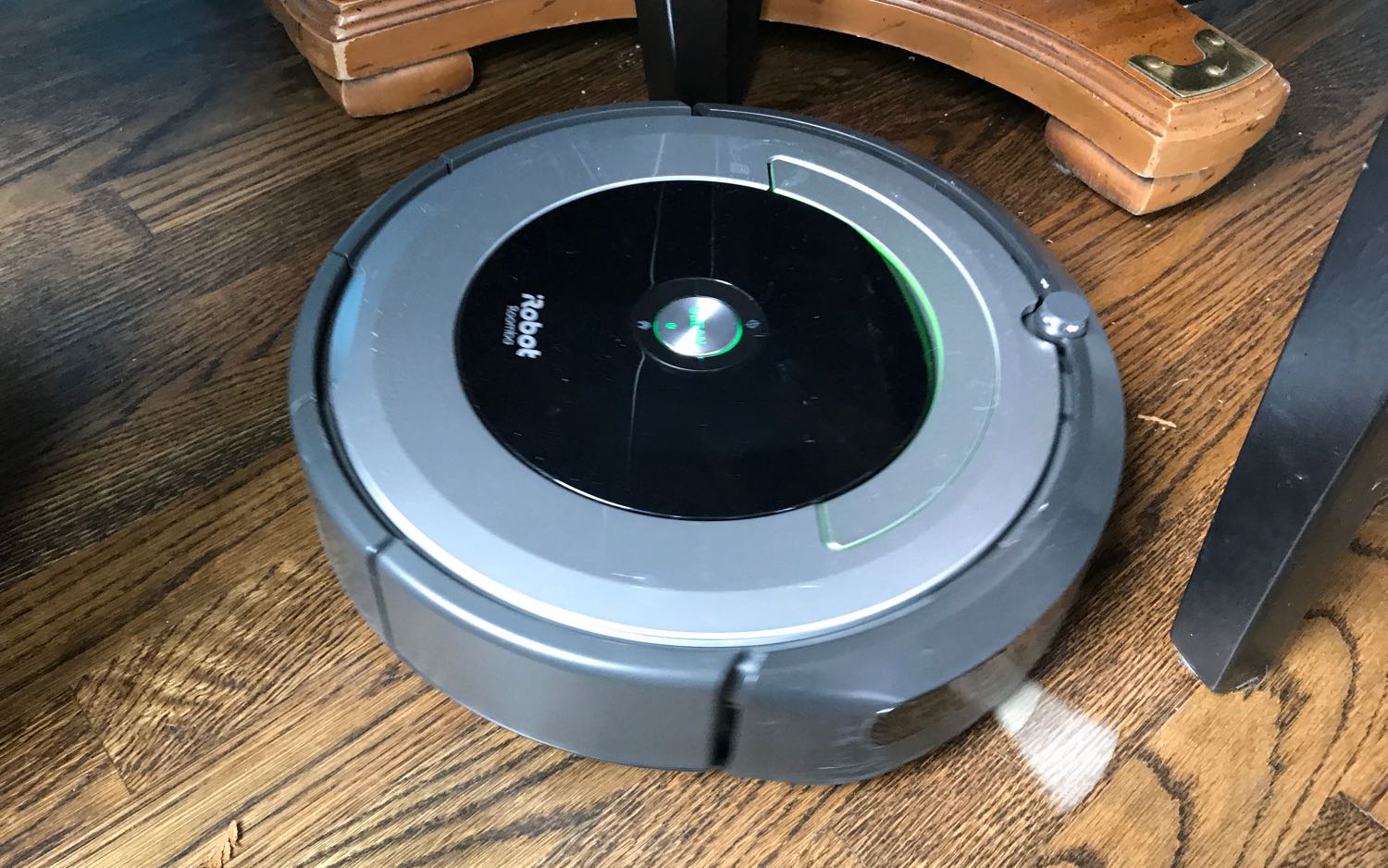Tom's Guide Verdict
The iRobot Roomba 690 is a solid, affordable connected robot vacuum, but it isn't the best for homes with pets. Those buyers should consider the Shark Ion instead.
Pros
- +
Affordable
- +
Easy-to-use app
- +
Maneuvers well in tight spaces
Cons
- -
Somewhat loud
- -
Dustbin too easy to remove
Why you can trust Tom's Guide
Is there anything better than coming home to a clean house? Or at least a clean floor? The iRobot Roomba 690 seeks to balance cost-effectiveness with the ease of using an app to order your robotic minion around. But while this midrange Roomba performs well enough to make our list of best robot vacuums, there are better options at this price.
Design
Like many robot vacuums, the 7.8-pound Roomba 690 has a circular design, measuring 13 inches in diameter, with ample plastic bumpers around the edge. Three buttons sit in the center of the 690: Clean, which doubles as the power button; Spot, a target icon for initiating spot cleaning; and Home, for sending the vacuum back to its home base.
Wi-Fi, battery and troubleshooting lights illuminate above the physical buttons when necessary. An unobtrusive black homing beacon sticks up slightly from the top. There's also a recessed carrying handle, which makes the Roomba 690 easy to carry between floors.
With a height of 3.7 inches, the Roomba 690 is taller than the 2.85-inch Eufy RoboVac 11S. But the 690 easily cleaned along the kick plate under our kitchen cabinets, sucking up the stray crumbs our regular vacuum can't reach. Though it didn't fit under a low-clearance couch, the Roomba 690 confidently disappeared under two living-room chairs.
The underside of the Roomba 690 features two large, springy rubber wheels and a small, swiveling, roller-type wheel. A bristle-brush roller sits parallel to a rubber-finned roller to assist with sucking up debris. There's one three-armed side brush on the right side of the vacuum. The dustbin pops out from the front side via a release button that was almost too easy to depress, so I was prone to accidentally loosening the bin.
MORE: Best Robot Vacuums
The Roomba's low-profile base is small and lightweight, but we wish it had built-in cord storage, like the Neato Robotics D7's base has. The Roomba got stuck on the cord once during our testing. Another time, the vacuum pushed the base just enough that it was unable to dock.
Get instant access to breaking news, the hottest reviews, great deals and helpful tips.
App and Setup: Supereasy
The Roomba 690's manual recommends placing the base in a location that leaves at least 1.5 feet on either side and at least 4 feet in front. This is a much smaller area than that required by the Shark Ion, which recommends 3 feet on either side and 5 feet in front. The Eufy RoboVac 11S needs even more space: 3 feet on the sides and 6 feet in front.
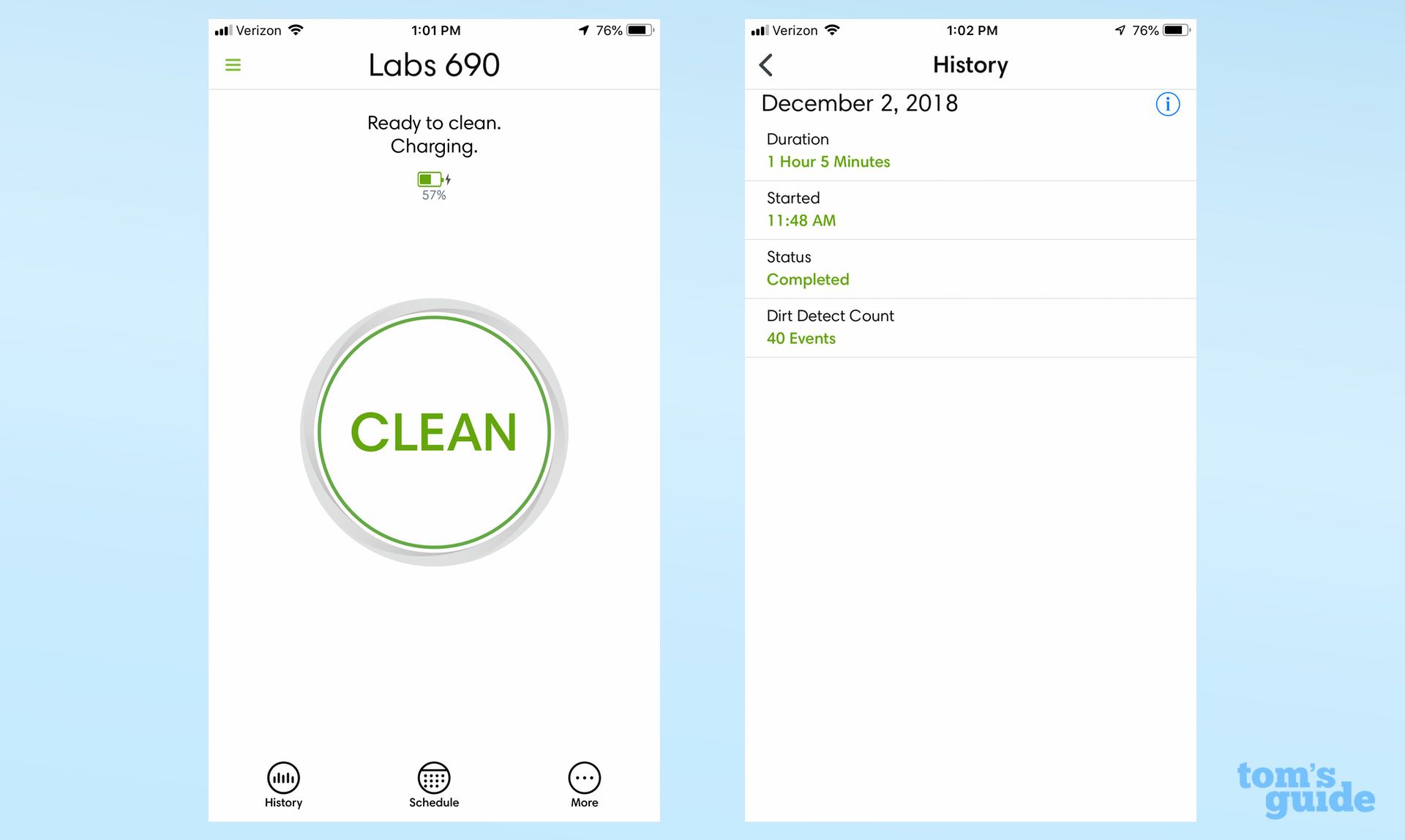
Though you can manually activate a cleaning by pressing the big Clean button on the vacuum, the real Roomba action comes from the companion iRobot app (Android and iOS). Simple, concise directions guide you through connecting to the Roomba 690's own Wi-Fi network to pair the vacuum with your phone and then connect it to your home network. The 690 makes happy, video-game-success-like sounds before its robotic female voice proudly announces it's connected.
The app's home screen mimics the button layout on the Roomba 690 but adds information about cleaning status and battery-charge level. Along the bottom, there are options for history, which gives performance and job information, and schedule setup. The Roomba 690 can be set to clean on a weekly schedule at any time and as often as once a day.
Though the Roomba 690 doesn't include a traditional remote, we didn't miss it. We were able to tell the 690 to get to work via Amazon Alexa and Google Home. It can also be controlled by IFTTT.
iRobot sells numerous replacement parts for the Roomba 690, ensuring that you'll be able to repair it instead of tossing it in a landfill.
Performance: Careful cleaner
Unlike the Shark Ion, the Roomba 690 has only one power option: Clean. iRobot says the 690 uses a "patented 3-Stage Cleaning System," but there were no options for Quiet or Max Clean like there are on the Shark Ion Robot.
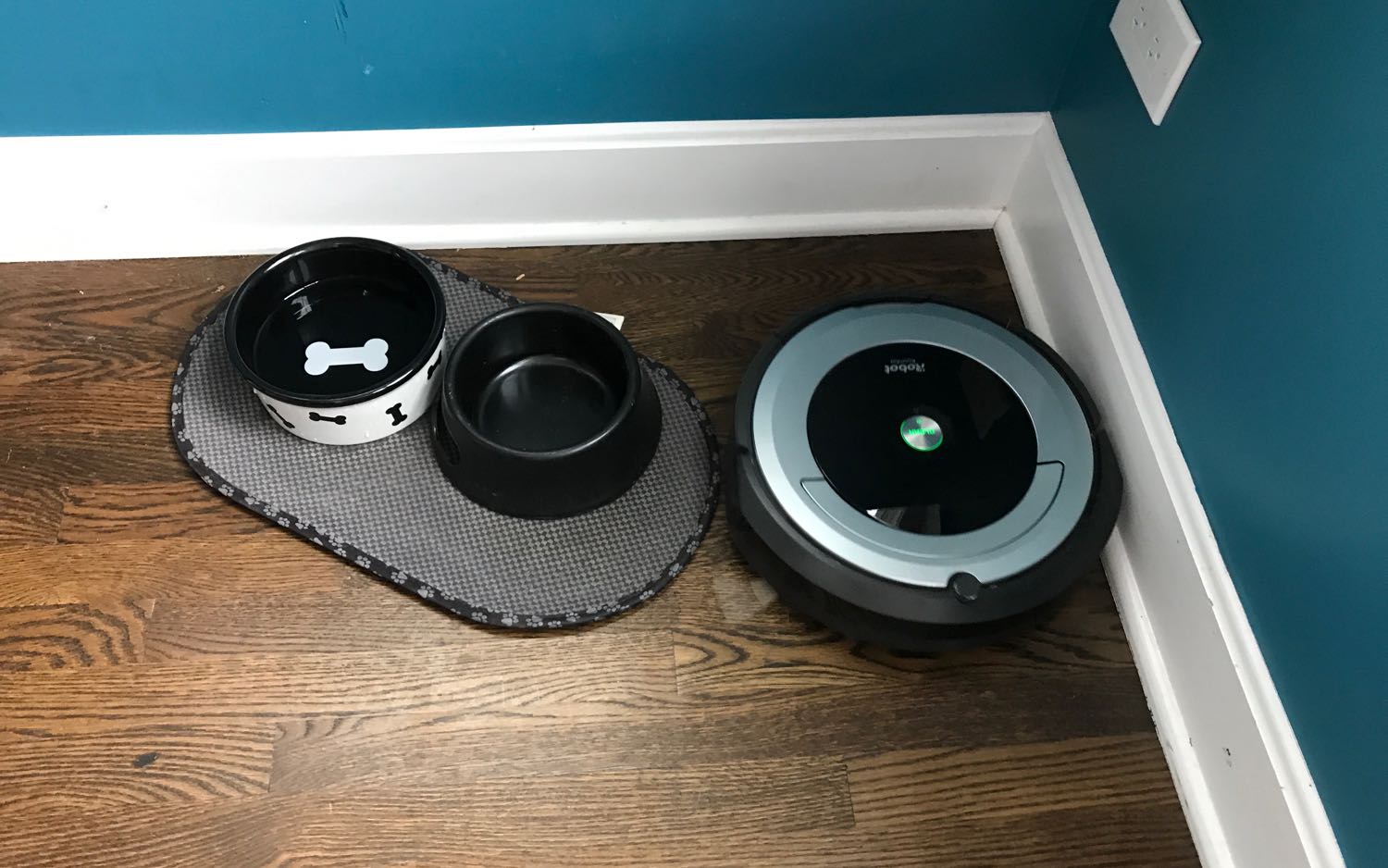
We set the Roomba 690 loose on the first floor of a house with a mostly open floor plan. The vacuum traversed a mix of hardwood floors, area rugs and doormats as it made its way through a living room, dining room, kitchen and bathroom.
We were impressed with how well the 690 maneuvered around dining room and kitchen furniture. Though the robot seemed to take its time figuring out how to navigate a tight maze of chair legs, it never got stuck. In the kitchen, it pushed around a place mat that sat beneath two dog bowls, but it was gentle enough that water didn't slosh out of the bowl. Overall, the Roomba was more thorough than both the RoboVac 11S and the Ion Robot as it sought out every nook and cranny it could find, then carefully worked its way out of those tight spots.
We were impressed with how well the Roomba 690 maneuvered around dining room and kitchen furniture.
On its first pass, the Roomba 690 completely missed our bathroom, which has hardwood floors. The vacuum also shied away from a flat, stone fireplace hearth, so it missed part of the living room. The cautious 'bot entirely avoided a 2.25-inch-thick shag carpet, a wise move considering the Eufy RoboVac 11S got tangled up in the shag twice during its attempts. The Shark Ion was more successful, but it also had trouble.
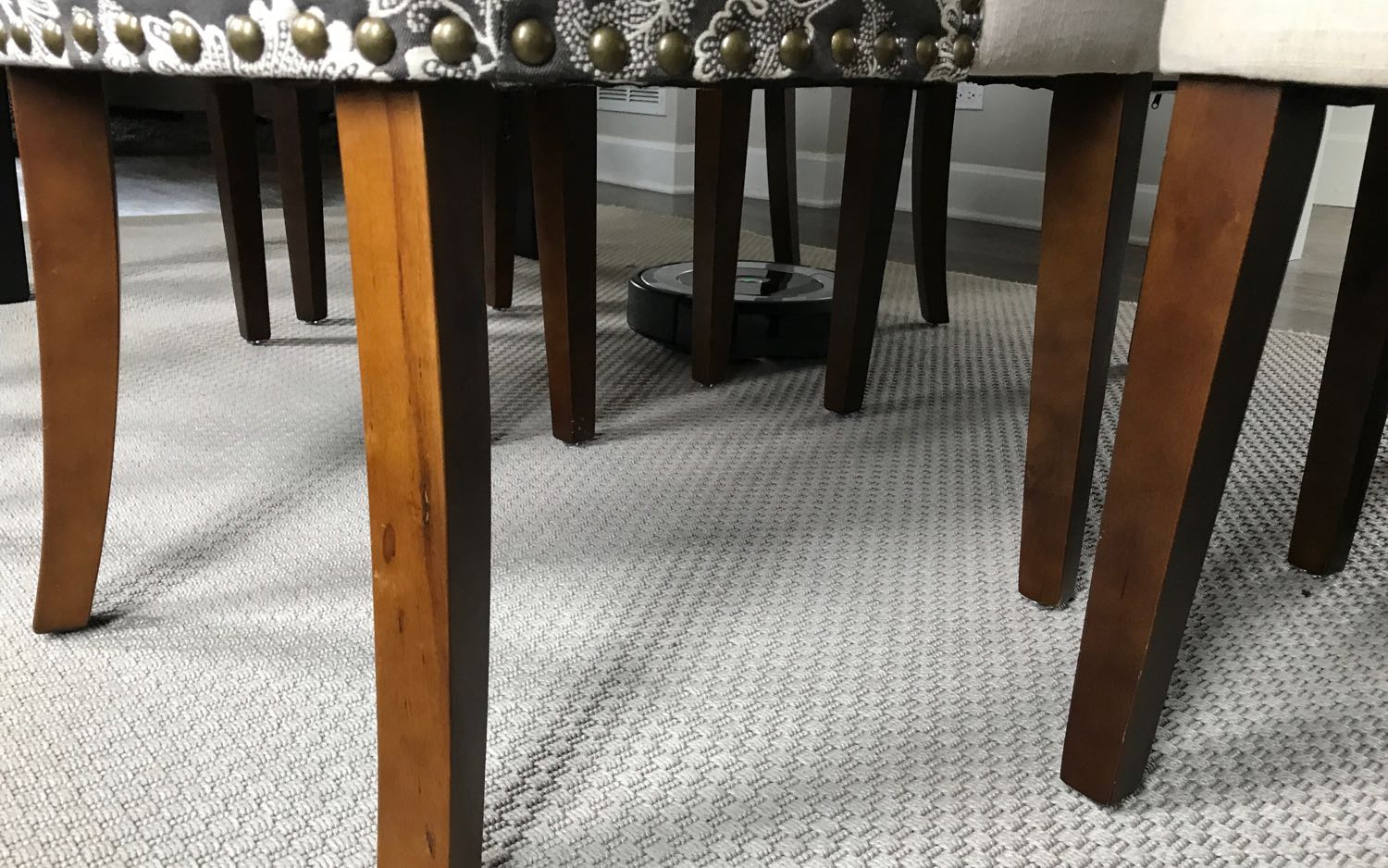
During another run, the 690 made a quick in-and-out visit to the bathroom and successfully conquered its fear of the hearth. The Shark Ion Robot followed a similar M.O., skipping both areas on its first cleaning. The RoboVac 11S hesitated on the hearth, but only for a few seconds before rolling over it.
While the Roomba 690 sucked up most things in its wake, it missed parts of a dead leaf and a thick piece of fuzz left over from a recent dog-toy dismemberment. The Ion Robot also pushed away the fuzz, but the RoboVac 11S picked the stuff up — only to embed it in its brush roller.
Releasing the Roomba 690's dustbin was easy enough, but removing the dirt was a little harder.
After cleaning, we noticed the three-armed side brush of the Roomba 690 had strands of hair wrapped around it. The rubber wheel axles also had thick pieces of dust and hair stuck in them, but that gunk was easy to remove with a sharp pull. iRobot includes instructions for removing the small roller wheel to dislodge debris.
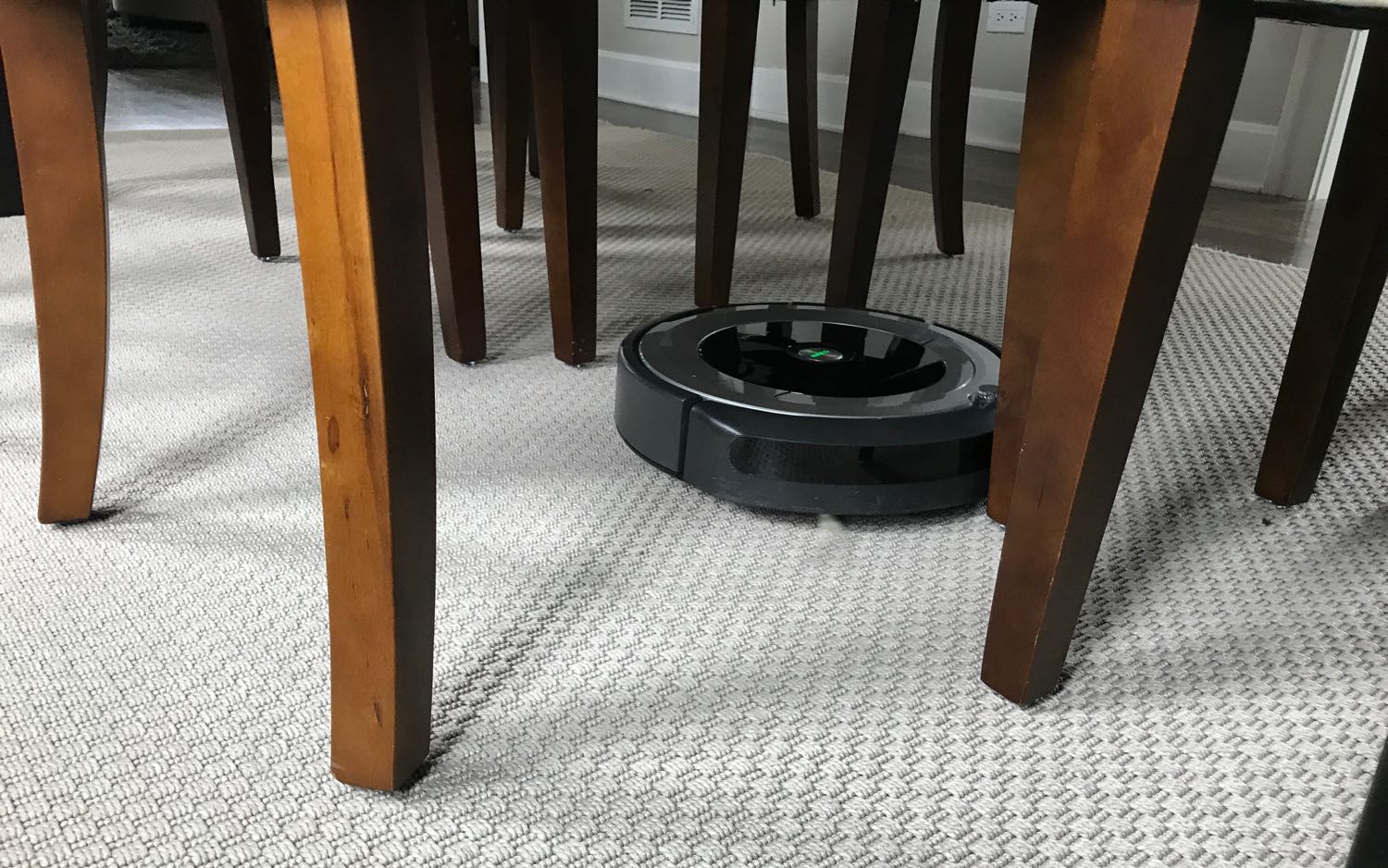
After commanding the 690 to head back to its base in the dining room via the app, we noticed that the robot took a very circuitous route. The vacuum was about 8 feet from the base, but instead of turning left, it chose to head right, sending it around the dining room table and off to the kitchen before it wound its way back home, cleaning the whole way.
Releasing the dustbin was easy enough, but removing the dirt was a little harder. The Roomba 690 has a small bar across the dustbin that easily swings open, theoretically allowing the dirt, dust and hair to just fall out with a light tap on the side of the garbage can. In reality, we had to use our hand to free the lightweight dust bunnies that had accumulated around the filter in the bin. This didn't cause a huge dust cloud, but people who are very sensitive to dust and allergens might want to avoid inhaling when emptying their Roomba 690.
Lab Test Results
| Smartphone control | Overall Cleaning Score | Avg. Cleaning Time (Hrs: Mins: Secs) | Cheerios Cleaning Score | Kitty Litter Cleaning Score | Dog Hair Cleaning Score | |
| Samsung PowerBot R7070 | Yes | 87.9 | 27:30 | 94.6 | 87.7 | 81.5 |
| iRobot Roomba 690 | Yes | 89.2 | 1:12:27 | 99.5 | 94.9 | 73.3 |
| Shark Ion Robot R85 | Yes | 94 | 1:01:57 | 100 | 94 | 88 |
| Eufy Robovac 11S | No | 85.8 | 1:18:00 | 100 | 90 | 67.5 |
As with all robot vacuums, we tested the Roomba 690 in our test lab, to see how the 'bot picked up Cheerios, kitty litter and dog hair on hardwood floor and carpet. The 690 performed admirably, as it scooped up an average of 99.5 percent of the Cheerios cereal on both surfaces, though the RoboVac 11S and Ion Robot bested the Roomba with perfect scores.
The Roomba 690 also sucked up 92.1 percent of the kitty litter we scattered on carpet, coming in a hair below the Ion Robot's 93 percent pickup rate but 7 points better than the result from the RoboVac 11S.
MORE: Our Favorite Smart Home Gadgets and Systems
The 690 averaged 73.3 percent when picking up dog hair on carpet and hardwood. That's better than the Eufy's result (67.5 percent), but not as good as the Shark Ion's showing (88 percent). This was echoed in our home testing, in which the Roomba took a chunk of fuzz for a tour of the living room before abandoning it.
Overall, the Roomba 690 took an average of 1 hour 12 minutes to complete its cleaning tasks, about 6 minutes faster than the Eufy 11S, but about 11 minutes slower than the Shark Ion.
In our lab tests, the Roomba 690 measured 66 decibels while cleaning, above the average loudness of 63.9 decibels for vacuums. We were able to conduct a loud conversation and mostly keep up with the Chicago Bears game while the vacuum was running, but it was hard to hear the ref's penalty calls over the Roomba's din.
Bottom Line
The iRobot Roomba 690 is a very good robot vacuum for the price. We loved how easily it maneuvered in tight areas, it had stellar performance picking up cereal and kitty litter, and its accompanying app is very easy to use.
However, the Shark Ion Robot was faster and better at picking up pet hair, and it’s not much more than the Roomba. If you have a lot of chairs and furniture that you don't want to move each time you vacuum, though, the Roomba 690 is a solid pick.
Credit: Tom's Guide
Meghan McDonough is a journalist who currently tests and writes about robot vacuums. Since 2008, she’s written about laptops, mobile phones, headphones, speakers, and other consumer tech. When she sees an unfamiliar device, Meghan has a habit of asking complete strangers, “What is that? Does it work well for you?”
In her spare time, Meghan enjoys seeing live music, tending to her garden, and playing endless games of fetch with her Goldendoodle, Duke of Squirrel.
